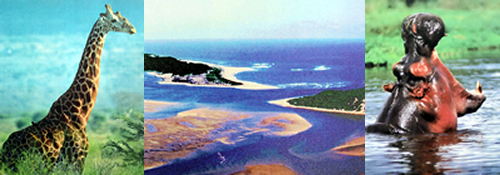|
|||||||||
Site Menu:
Are you one of year 2007’s Forbes magazine's 946 billionairs who might be interested in an exceptional world class do-good-charitable-altrustic-benevolent development that is world class unique while a self sustaining cash cow, that will create your enduring living legacy to leave behind for applauding and appreciative...
The 4000 Sq Mi Elephant Coast development will connect up to the Grand Limpopo Transfrontier Park the world’s largest wildlife refuge in the world at 38,500 Sq Mi, by almost a factor of two.
The Elephant Coast development project could save 5000 Kruger National Park elephants doomed to culling (killing) due to overstocking, resulting overgrazing, and ecosystem ...
Safeguard the Maputaland Center of Plant Diversity—which fortuitiusly is completely inside the proposed 4000 Sq Mi Elephant Coast development.
Wildlife tourism beats out gold mining bullion as South Africa’s traditional top
GDP producer in 2005.
|
Home Page
Save Mozambique's Elephant Coast? What or where is it? The CAUSE and enduring-living-legacy OPPORTUNITY it provides is about safeguarding for humanity an exhilarating pristine 50 mile stretch of Mozambique's high forested dune Indian Ocean Coast and hinterland from Inhaca Island, eighteen miles east across Maputo Bay from Mozambique's Capital Maputo---Lourenco Marques in Portuguese days---south through the Machangulo Peninsula. Then widening out through the Maputo Elephant Reserve (created in 1932), just south of the Peninsula to the South African KwaZulu Natal border, west to the Maputo River. Elephants used to bath in the Indian Ocean at Ponta Milibangalala, a rarely seen wildlifes affinity for salt water except for that one mammal, Man and maybe his accompanying dogs, as the 1996 development region is blessed with 40 lakes and the mighty Maputo River as its west boundary. Safeguard it how? By recreating Mother Nature's Wildlife Wonderland Africa---a wildlife-watching-ecotourism keep it NATIVE-and-UNSPOILED `development', with a few bells and whistles sun-sea-and-sand activities at the `front-door' north end in the sheltered western inner bay of the Peninsula and Inhaca Island. The Portuguese bailed out of Mozambique in 1975, capitulating in their since 1962 resistance to the war for black independence. Meanwhile international Marxism had infiltrated the African cause for independence. Then the Cubans came, in military helicopters, their aerial machine guns extinguished 500 of the 600 elephants, a last rhino by 1981, leaving the Maputo Elephant Reserve with bleached skulls and bones and a graveyard silence, and only 100 skittish gun shy elephants---still being poached---and a few hippo and Nile crocodile in some lakes. South Africa---and it is rumored the CIA---supported RENAMO or Resistance National Mozambican, the west's manufactured antidote to resist a Marxist foothold in southern African, via FRELIMO, Liberation Front of Mozambique---the entity who took power when the Protuguese bailed in 1975. RENAMO infiltrated in from South Africa's KwaZulu Natal. They cleared out the region south of the Elephant Reserve of cattle and humans, in a bloody ongoing civil war phase two, until peace in 1992, after some 30 years of continuous civil strife. This had reduced the Elephant Coast region back to a near pre-Agricultural Revolution time warp but for its surviving diamond-in-the-rough botanical and geographical treasures, unrecognized and unappreciated gifts from God and Mother Nature.
The UN met at its 1992 first Earth Summit in Rio where the world's heads of state signed the International Biodiversity Accord. The Accord was to designate Centers of Plant Diversity (CPD) worldwide, to be protected and safeguarded native-and-unspoiled for Posterity as our earth's richest surviving botanical sites---a plant and tree sister act to the `Endangered-Species-Act' protecting endangered mammals, birds, fish and reptile. The three volumes of `Centres of Plant Diversity' (1994) named 250 sites worldwide, 84 in Africa for protection and safeguarding 'native-and-unspoiled' under the International Biodiversity Accord. One was the Maputaland Center of Plant Diversity (CPD) of the whole Elephant Coast ecosystem, but extending even further south into KwaZulu Natal, west into neighboring Swaziland and to north of the Capital Maputo. The book Save Mozambique's Elephant Coast's, is by an engineer-by-default 'author' after his 30 year key man Project Manager career in heavy construction that took him to live and work on every continent but Antarctica---17 years in Africa, when he had a fortuitous meeting. Or a stranger-than-fiction link in a plot that unfolded like it was orcestrated by a higher power? On a to-the-North-Pole adventure trip our hard-nosed construction-stiff-engineer-to-be-bleeding-heart author came to know New Orleans entrepreneur, Libertarian gold bug, paraplegic Jim, and Jim of the to-be author's unique international construction-engineering resume; that both were aficionados of African wildlife and native cultures. Then in 1995---somehow strangely guided---New Orleans Jim an `invest-when-there-is-still-blood-in-the-streets' advocate is ushered in to meet Mozambique's President Chissano, is offered a 99 year land development lease to develop the 40,000 acre Machangulo Peninsula, sandwiched between Inhaca Island to its north and the by-now-shot-out Maputo Elephant Reserve to its south. But Jim has to do a feasibility study to gain the approval of the Mozambique Council of Ministers. After dithering delay, then in desperation Jim calls his North Pole acquaintance, worldwide-remote-beach-head-no-infrastructure-projects construction stiff acquaintance to help. With several hints of guidance from above, 10 months later Jim has his feasibility plan, but for near fifteen times its original size at 585,000 acres (914 Sq Mi), his 99 year land lease is awarded by the Mozambique Government in October 1996. But New Orleans Jim (or his take-over-Machiavellian-plotting lawyer) gets ride of the professionals, Jim goes off radar, fails miserably to perform in a classic bait-then-switch. Jim dies in 1999 at age 54 (A to Z blow-by-blow in book's part II Chapters 7 thru 25). The Elephant Coast wildlife ecotourism development and UN mandated CPD falls in a crack. Jim's North Pole friend et al in a labor-of-love effort are now trying to resurrect and expand the development, as a new and improved do-good-altruistic-charitable-benevolent-cash cow 4000 Sq Mi development. That is just the tip-of-the-iceberg of where and what 501-c-3 (applied for) `Save Mozambique's Elephant Coast' CAUSE and enduring-living-legacy OPPORTUNITY is all about.
|
||||||||
|
www.savemozambiqueselephantcoast.org © 2007
Home Page | Cause and Opportunity | History | Policies | Video Page | Faq's | Links | Contact Graphic Design by Local Tech Service |
|||||||||









